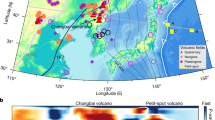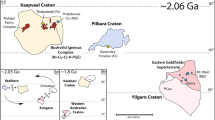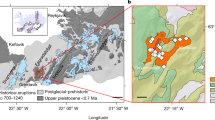Abstract
BASALTIC magmatism results when upwelling mantle crosses the peridotite solidus. The greater the overstep of the solidus, the greater the degree of mantle melting and the larger the volume of magma produced. In Iceland most of the active volcanism occurs along the central spreading axis, although some occurs in isolated off-axis volcanoes such as Snaefellsjökull. Because the mantle beneath Snaefellsjökull is not upwelling as vigorously as that beneath the spreading axis, it oversteps its solidus by a much smaller amount and consequently the degree of melting is less. The composition of the resulting magma will be much more sensitive to small perturbations in the amount of upwelling than will the mantle beneath the ridge axis. We show here that the reduction of pressure in the mantle caused by the unloading of ice was sufficient to affect magma composition. Unloading was accompanied by a clear shift towards less undersaturated magma compositions, which reflect a transient increase of about 0.5% in the degree of mantle melting, coupled with a decrease in depth of melting.
This is a preview of subscription content, access via your institution
Access options
Subscribe to this journal
Receive 51 print issues and online access
$199.00 per year
only $3.90 per issue
Buy this article
- Purchase on Springer Link
- Instant access to full article PDF
Prices may be subject to local taxes which are calculated during checkout
Similar content being viewed by others
References
McKenzie, D. & Bickle, M. J. J. Petrol. 29, 625–679 (1988).
Saemundsson, K. Jökull 29, 7–28 (1980).
Johannesson, H., Flores, R. M. & Jonsson, J. Jökull 31, 23–30 (1981).
Fitton, J. G. & Dunlop, H. M. Earth planet. Sci. Lett. 72, 23–38 (1985).
Fairbanks, R. G. Nature 342, 637–642 (1989).
Hofmann, A. W. Earth planet. Sci. Lett. 90, 297–314 (1988).
McKenzie, D. & O'Nions, R. K. J. Petrol (in the press).
McKenzie, D. P. J. Petrol. 25, 713–765 (1984).
Thors, K. & Boulton, G. S. Marine Geol. 98, 99–112 (1991).
Thors, K. & Helgadottir, G. in Environmental Change in Iceland (eds Maizels, J. & Caseldine, C.) (in the press).
Einarsson, Th. Geology, Story of Rock and Country (in Icelandic) 355 (Mal & Menning, Reykjavik, 1968).
Watson, S. & McKenzie, D. J. Petrol. 32, 501–537 (1991).
Mysen, B. O. & Kushiro, I. Am. Miner. 62, 843–865 (1977).
Nicholson, H. thesis, Univ. of Edinburgh (1990).
Sigvaldason, G. E. & Steinthorsson, S. Geodynamics of Iceland and the North Atlantic Area (ed. Kristjansson, L.) 155–164 (Reidel, Dordrecht, 1974).
Jakobsson, S. P. Acta Nat. Islandica 26, 103 (1979).
Author information
Authors and Affiliations
Rights and permissions
About this article
Cite this article
Hardarson, B., Fitton, J. Increased mantle melting beneath Snaefellsjökull volcano during Late Pleistocene deglaciation. Nature 353, 62–64 (1991). https://doi.org/10.1038/353062a0
Received:
Accepted:
Issue Date:
DOI: https://doi.org/10.1038/353062a0
This article is cited by
-
Dyke to sill deflection in the shallow heterogeneous crust during glacier retreat: part I
Bulletin of Volcanology (2023)
-
Petrography, mineral chemistry and geochemistry of quaternary volcanism from Wakwa plain, Adamawa Massif (Cameroon Volcanic Line, West-central Africa)
Arabian Journal of Geosciences (2022)
-
The Bafoussam volcanic series: origin and evolution of the volcanism along the Cameroon volcanic line
Acta Geochimica (2022)
-
Mantle source evolution beneath the Cameroon volcanic line: geochemical and geochronological evidences from Fotouni volcanic series, Western Cameroon
Arabian Journal of Geosciences (2020)
-
In situ cosmogenic 3He and 36Cl and radiocarbon dating of volcanic deposits refine the Pleistocene and Holocene eruption chronology of SW Peru
Bulletin of Volcanology (2019)
Comments
By submitting a comment you agree to abide by our Terms and Community Guidelines. If you find something abusive or that does not comply with our terms or guidelines please flag it as inappropriate.



